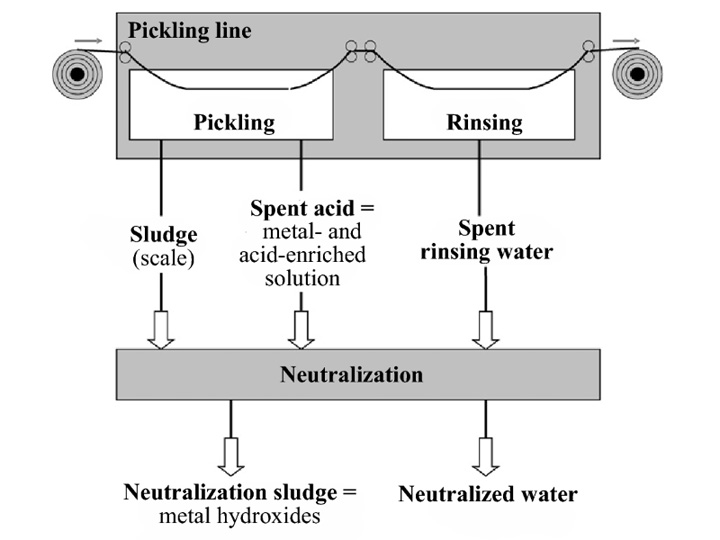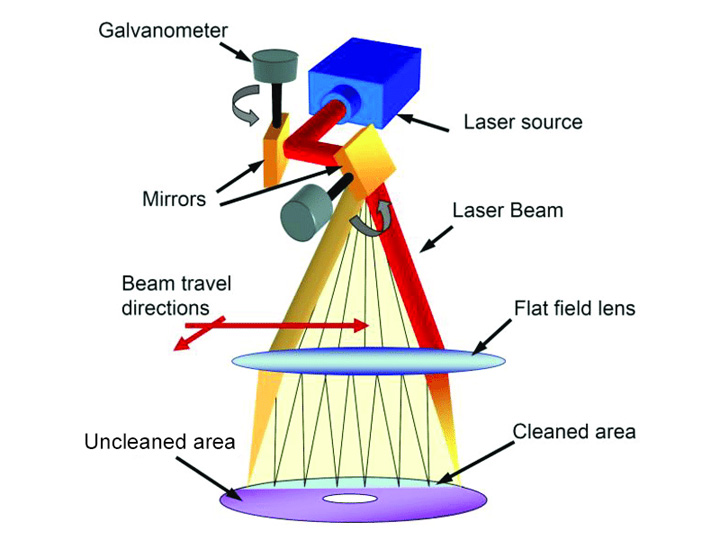Laser cleaning and pickling are two different methods for treating metal surfaces. Laser cleaning is a metal surface treatment process that uses a laser beam emitted by a laser generator to generate high energy to remove rust, strip paint, and remove coatings. Pickling is a treatment method used to remove rust, stains, impurities, or contaminants from the surfaces of metals.
Pickling
The pickling sheet is made of high-quality hot-rolled sheet as raw material, and the oxide layer is removed by the pickling unit, trimmed, and finished. The intermediate product between the plates, on the premise of ensuring the surface quality and use requirements, enables users to effectively reduce the procurement cost.
Pickling Sheets Advantages
1. The surface quality is good, because the surface iron oxide scale is removed from the hot-rolled pickling plate, which improves the surface quality of the steel and facilitates welding, oiling and painting.
2. High dimensional accuracy, after flattening, the plate shape can be changed to a certain extent, thereby reducing the deviation of unevenness.
3. Improves surface finish and enhances appearance.
Applications
It can be said that pickling sheet is a cost-effective product between cold-rolled sheet and hot-rolled sheet. It has a wide range of applications in the automotive industry, machinery industry, light industrial appliances and stamping parts of various shapes, such as beams, sub-beams, rims, spokes, carriage panels, fans, chemical oil drums, welded pipes, electrical cabinets, fences, Iron ladders, etc., have broad market prospects. Below we will introduce the technical process of the pickling process.
Pickling Principle
Pickling is a surface process that uses an acid solution to remove scale and rust on the surface of steel, usually together with pre-filming. Generally, the workpiece is immersed in a chemical solution such as sulfuric acid to remove oxides and other films on the metal surface, which is the pre-treatment or intermediate treatment of electroplating, enamel, rolling and other processes. Also known as wet cleaning.
The pickling process mainly includes dipping pickling method, spray pickling method and acid paste rust removal method.
The acids used are mostly sulfuric acid, hydrochloric acid, phosphoric acid, nitric acid, chromic acid, hydrofluoric acid and mixed acids.
Process Flow
Hanging on metal parts → chemical degreasing (conventional alkaline chemical degreasing or surfactant degreasing) → hot water washing → running water washing → the first step of pickling → Running water washing → Second step pickling → running water washing → transfer to the next process (such as: chemical coloring → recycling → running water washing → hardening treatment → Washing → Closing Treatment → Washing → Drying → Finished).
Common Defects
Iron oxide scale intrusion: Iron oxide scale intrusion is a surface defect formed during hot rolling. After pickling, it is often pressed in in the shape of black dots and strips, the surface is rough, generally has a hand feel, and appears sporadically or intensively. It is often caused by imperfect heating process, descaling process and rolling process of pickling.
Oxygen spot (surface landscape painting): refers to the dot-like, linear or pit-like appearance left after the iron oxide scale on the surface of the hot-rolled steel is washed off. The rolling is pressed into the matrix, which is highlighted after pickling. It has a certain effect on the appearance, but does not affect the performance.
Macular: yellow spots appear on part or the whole board surface, which cannot be covered after oiling, which affects the quality and appearance of the product. The main reason is that the surface activity of the strip just out of the pickling tank is high, the rinsing water fails to wash the strip normally, the spray beam and nozzle of the rinse tank are blocked, and the angles are not equal.
Under-pickling: The surface of the strip steel has local iron oxide scales that are not cleanly and insufficiently removed, and the plate surface is gray-black, with fish scales or horizontal water ripples. It has something to do with the acid process, mainly because the acid concentration is insufficient, the temperature is not high, the strip runs too fast, and the strip cannot be immersed in the acid.
Over-pickling: The surface of the strip steel is often dark black or brownish black, showing block, flaky black spots or macular, and the surface of the plate is generally rough. The reason is the opposite of underpickling.
Environmental Pollution
The main pollutants in the production process are the cleaning wastewater produced by the water washing process at all levels, the dust produced by the sandblasting process, the hydrogen chloride acid mist produced by the pickling process, and the waste produced by the pickling, rinsing, phosphating, neutralization and rust prevention processes. Tank liquid, waste residue, waste filter element, raw material empty barrels and packaging waste, etc. The main pollutants are hydrogen chloride, pH, SS, COD, BOD?, ammonia nitrogen, petroleum, etc.
Laser Cleaning
Cleaning Principle
Laser cleaning machine is to use laser energy to penetrate the surface of the object. The electrons in the material absorb energy vibration for about 100 femtoseconds, and generate plasma on the surface of the material. After 7-10 picoseconds, the electron energy is transferred to the lattice and the lattice starts to vibrate. After the picosecond, the object begins to generate a macro temperature, and the local material irradiated by the laser begins to heat up, melt and vaporize, so as to achieve the purpose of cleaning.
Cleaning Process & Effect
Compared with the pickling method, the laser cleaning system is very simple, no pretreatment is required, and the cleaning work of oil removal, oxide layer removal and rust removal can be carried out at the same time. Just turn on the device to let out the light, then clean it.
Laser cleaning system can reach the highest industrial cleaning level of Sa3 level, almost no damage to the hardness, hydrophilicity and hydrophobicity of the material surface. It is more thorough than pickling.
Pros and Cons
Process Flow and Operation Requirements
Compared with the pickling tool with more than a dozen processes, laser cleaner has achieved the most simplified process and basically achieved one step. Greatly shortens cleaning time and material loss.
The pickling method has strict requirements on the operation process: the workpiece must be completely degreasing to ensure the quality of rust removal; the concentration of the pickling solution is controlled to prevent the workpiece from being corroded due to excessive acid concentration; the temperature is controlled according to the process specifications to avoid damage to the workpiece and The equipment causes corrosion; the pickling tank gradually deposits sludge, which blocks the heating pipe and other control devices, and needs to be removed regularly; in addition, it is necessary to pay attention to the pickling time, injection pressure, operation sputtering, exhaust equipment, etc.
Laser cleaning can realize fool-like operation or even automatic unmanned operation after setting parameters in the early stage.
Cleaning Effect and Environmental Pollution
In addition to the stronger cleaning effect, laser cleaning system also has the advantage of greater fault tolerance.
Oxygen macular, redness and blackening often occur due to mistakes in the operation of the pickling method, and the rejection rate is high.
The water drop laser experiment proves that even if the laser cleaning is supersaturated, it still has a strong metallic luster, and does not produce hydroxide and other pollutants, which will not affect the next processing methods such as welding.
There will be no environmental pollution such as waste liquid and slag in the whole process of laser cleaning, which is the greenest cleaning method.
Unit Cost VS Conversion Cost
The pickling tool requires chemicals as consumables, so the unit cost consists of equipment depreciation + consumables cost.
Laser cleaning machine requires no consumables other than purchasing equipment. The unit cost is the depreciation of the equipment.
Therefore, the larger the cleaning scale and the longer the years, the lower the unit cost of laser cleaning.
The composition of the pickling production line requires complex processes, and the ratio of pickling agents for different metal materials is not the same, so the conversion production line requires a large conversion cost, and the metal material to be cleaned in a short period of time is single and cannot be flexibly changed.
There is no conversion cost for laser cleaning: after switching the software parameters of the same cleaning machine, the effect of cleaning the steel plate one minute and the aluminum alloy the next minute can be achieved. It is convenient for enterprises to implement JIT flexible production.
Summarize
Pickling plate has a wide range and in-depth application in manufacturing production, and plays a positive role in industrial support. However, with the continuous upgrading of the manufacturing industry, capacity optimization and structural adjustment are also being carried out slowly.
With the enhancement of people’s environmental awareness, the government and enterprises have increasingly stringent requirements for pickling production lines, and the profit margins of related enterprises are getting thinner and thinner. The overall environment is more favorable for laser cleaning.
Maybe in the next decade, pickling sheets will have a new name – laser cleaning sheets.



